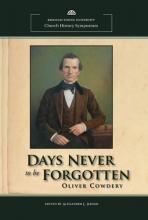 I’ve mentioned before the book Days Never to Be Forgotten. This is the published version of a Church History Symposium held on November 10, 2006, at BYU. It contains thoughtful articles that focus on the life and times of Oliver Cowdery.
I’ve mentioned before the book Days Never to Be Forgotten. This is the published version of a Church History Symposium held on November 10, 2006, at BYU. It contains thoughtful articles that focus on the life and times of Oliver Cowdery.
The entire book is available online here (BYU’s Religious Studies Center). RSC is a resource I highly recommend to everyone.
Today I want to focus on the parts of the book that discuss Oliver’s role as editor and author when he wrote and published the eight letters about Church history. Of course, the seventh letter–Letter VII–is the main topic of this blog, but all the letters are important.
Chapter 1 makes this observation. “From October 1834 through October 1835, Oliver published eight letters in the Latter Day Saints’ Messenger and Advocate. This was the first published account of Joseph’s “marvilous experience” and one of three major sources dealing with his early years along with Lucy Smith’s Biographical Sketches and Joseph’s own manuscript history. Joseph wrote a brief history in 1832 but did not publish it. His longer account was not begun until 1838. Lucy’s narrative was dictated after the Prophet’s death. Thus, for a number of years, Oliver’s account stood alone.”
Chapter 9 adds additional commentary, noting that “Taken together, [the eight letters] constitute one of the earliest recorded histories of the Palmyra period. [Oliver] was not able to cover the swath of history he had hoped (from the First Vision to the expulsion from Jackson County), but he was able to cover from the First Vision to the restoration of the Aaronic Priesthood. Cowdery’s history is invaluable because it contains details that are unique to it, and it is much more detailed than those accounts left by the Prophet himself. But because Cowdery writes that Joseph assisted him with the writing of this history, the division between Cowdery’s and Joseph’s versions may be a false construct.”
These are important points to remember. Oliver’s account was the first one to relate many of the critical early historical events and it was the most detailed. Plus, the details about what Joseph was thinking and his experiences with Moroni indicate that these letters were a joint effort between Joseph and Oliver. That’s why Joseph had his scribes copy them into his journal as part of his history, and why he approved their republication in the Gospel Reflector and the Times and Seasons.
Those scholars who reject Oliver’s Letter VII explanation of the Hill Cumorah being in New York must explain how Oliver’s work could be so important on every other point but that one.
________________
The handful of scholars who continue to reject Oliver Cowdery’s Letter VII basically say that neither Oliver nor Joseph claimed to receive revelation about the site of the final battles. But why would they need specific revelation on that point when they had visited the room that contained all the Nephite records Mormon said he deposited in the Hill Cumorah? (See Mormon 6:6).
I know this is redundant, but I want this to be clear for the non-scholars who don’t study this all the time, so let me state this another way, by analogy.
The scholars’ argument is akin to this:
Let’s say someone (let’s call him Fred) visits the Salt Lake temple today and from that concludes that the Salt Lake Valley is the valley Brigham Young entered in 1847, based on the contemporaneous accounts of Brigham Young specifying the site for the temple and overseeing its initial construction. He writes down his conclusion.
Then, let’s say the Salt Lake temple is destroyed 100 years from now, and a group of scholars comes along and read’s Fred’s statement. The scholars decide it was impossible for a temple to have been built in Salt Lake because there’s no granite in the valley. Instead, these scholars decide Fred must have merely had a vision of the temple, and the temple was actually someplace in Mexico.
These same scholars insist Fred could not have “known” Brigham Young entered the Salt Lake Valley because 1) he didn’t really see the temple there, despite what he wrote, and 2) he never claimed to have received a revelation about where Brigham Young actually built the temple.
_____________
Source: Letter VII
